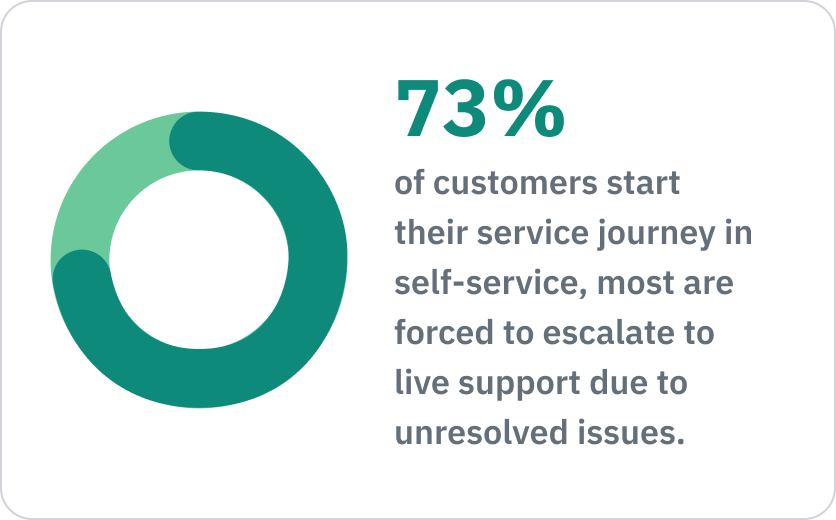Author: Simon Fraser, Vice President, CX Strategy & Enablement, InMoment
A recent Gartner survey highlighted a troubling reality: only 14% of customer service issues are fully resolved through self-service channels. Despite self-service becoming a staple in modern customer support, the majority of customers still face unresolved issues, pushing them to seek further assistance.
Customers who value the convenience of self-service can become frustrated when their needs aren’t addressed, especially for simple issues where resolution rates are only 36%. For those who have no choice but to use self-service channels, this stark inefficiency results in:


Longer Wait Times

Higher Operational Costs

Customer Frustration

Increased Customer Effort
So… Why is this Happening?
For many organizations, self-service platforms are struggling to keep up with today’s complex customer service demands. They often fail to understand customer intent, provide inadequate follow-up, and feature outdated or irrelevant content. A staggering 43% of customers report being unable to find relevant information, while 45% feel that companies don’t understand their needs. These issues underscore a major disconnect between customer expectations and the capabilities of existing self-service systems. The rigidity of these solutions, coupled with a lack of real-time adaptability, results in customer frustration and disengagement.

The Hidden Cost of Frustration
The consequences of these failures are profound. Frustrated customers are more likely to switch to competitors, and the added burden on customer service teams leads to longer response times and increased operational costs. According to Gartner, while 73% of customers start their service journey in self-service, most are forced to escalate to live support due to unresolved issues. This frustration not only harms customer perceptions of the brand but also diminishes trust and increases the likelihood of churn.

Turning the Tide on Self-Service Failures
At InMoment, we see self-service as more than a one-size-fits-all solution; it’s a pivotal element in crafting an outstanding customer experience. We understand that each interaction is a chance to either enhance customer loyalty or jeopardize it. Our approach merges cutting-edge technology with a profound understanding of customer journeys to deliver solutions that truly meet their needs. To help you elevate your self-service strategy and transform it from a source of frustration into a powerful asset, here are my top five recommendations:

Proactively Anticipating Customer Needs
Effective self-service starts with understanding what customers need before they even realize it. Too often, customers only seek help when they’re already frustrated. To counter this, we advocate for a proactive approach. By analyzing digital interactions, chatbot conversations, and post-IVR surveys, we gain valuable insights into customer behavior. With data on hand—like account history and product usage—we can predict needs and offer solutions before issues escalate. This proactive stance ensures customers receive timely answers without extra hassle.

Scaling and Maintaining Self-Service Content
A major reason self-service fails is outdated or irrelevant content. If customers can’t find accurate answers, they lose trust in the system. To address this, we need to continuously update and refine content based on real-time feedback. Integrating this into the regular workflow ensures that self-service tools remain relevant and effective, adapting to evolving customer needs. This continuous improvement helps create a system that learns and evolves, providing the right solutions when customers need them most.

Simplifying the Path to Resolution
Navigating self-service shouldn’t feel like maneuvering through a maze. The goal is to create a straightforward, user-friendly journey. By using AI-driven solutions and advanced analytics, we can predict customer intent and provide personalized recommendations. Tools like digital concierges and streamlined knowledge bases help ensure customers find the help they need quickly and easily, reducing frustration and improving the overall experience.

Real-Time Feedback Loops and Continuous Content
Improvement
A successful self-service strategy requires ongoing evolution. Real-time feedback
loops are essential, allowing both customers and service reps to flag outdated or
ineffective content. This approach ensures that self-service tools are constantly
reviewed and updated. Instead of a “set it and forget it” mentality, we focus on
continuous improvement—using real-time insights and customer trends to keep the
system smart and aligned with customer needs.

Harnessing AI for Advanced Predictive Support
AI-driven predictive analytics transform customer support by shifting from reactive to anticipatory. By harnessing sophisticated algorithms to analyze extensive customer data—such as product usage patterns and historical interactions—we can pinpoint potential issues before they materialize. This approach allows us to preemptively address concerns, delivering tailored solutions before customers even recognize a problem. Integrating AI into our support strategy ensures a seamless, proactive experience that resolves issues before they escalate, providing a more intuitive and efficient service.
The Future of CX: Proactive, Not Reactive
The Gartner survey highlights that effective self-service can significantly boost customer experiences, reduce churn, and enhance efficiency. I believe that self-service should be more than a fallback option; it should be an integral part of exceptional customer experiences. By adopting a proactive approach—leveraging predictive analytics, real-time feedback, and continuous improvement—businesses can transform self-service from a source of frustration into a powerful asset.
In today’s world, where customer loyalty is increasingly fragile, it’s crucial to make customers feel truly understood and supported. We need to go beyond simply meeting expectations; we should aim to exceed them. By addressing issues like fragmented journeys and outdated content, we can shift the customer experience from reactive to proactive, delivering the seamless, intuitive service that customers not only want but deserve. With the right tools and strategies, companies can build stronger, more loyal relationships and ensure that their self-service solutions empower rather than frustrate.
You can download the full PoV as a PDF by clicking the button below!
